remove seats CHEVROLET HHR 2011 1.G Owners Manual
[x] Cancel search | Manufacturer: CHEVROLET, Model Year: 2011, Model line: HHR, Model: CHEVROLET HHR 2011 1.GPages: 430, PDF Size: 4.57 MB
Page 42 of 430
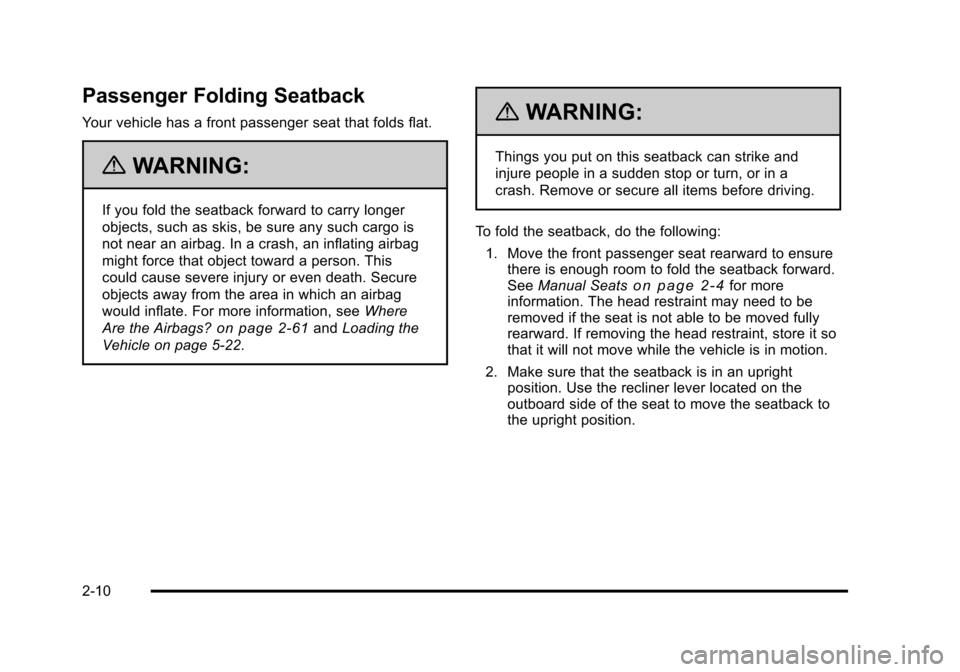
Black plate (10,1)Chevrolet HHR Owner Manual - 2011
Passenger Folding Seatback
Your vehicle has a front passenger seat that folds flat.
{WARNING:
If you fold the seatback forward to carry longer
objects, such as skis, be sure any such cargo is
not near an airbag. In a crash, an inflating airbag
might force that object toward a person. This
could cause severe injury or even death. Secure
objects away from the area in which an airbag
would inflate. For more information, seeWhere
Are the Airbags?
on page 2‑61and Loading the
Vehicle on page 5‑22.
{WARNING:
Things you put on this seatback can strike and
injure people in a sudden stop or turn, or in a
crash. Remove or secure all items before driving.
To fold the seatback, do the following: 1. Move the front passenger seat rearward to ensure there is enough room to fold the seatback forward.
See Manual Seats
on page 2‑4for more
information. The head restraint may need to be
removed if the seat is not able to be moved fully
rearward. If removing the head restraint, store it so
that it will not move while the vehicle is in motion.
2. Make sure that the seatback is in an upright position. Use the recliner lever located on the
outboard side of the seat to move the seatback to
the upright position.
2-10
Page 44 of 430
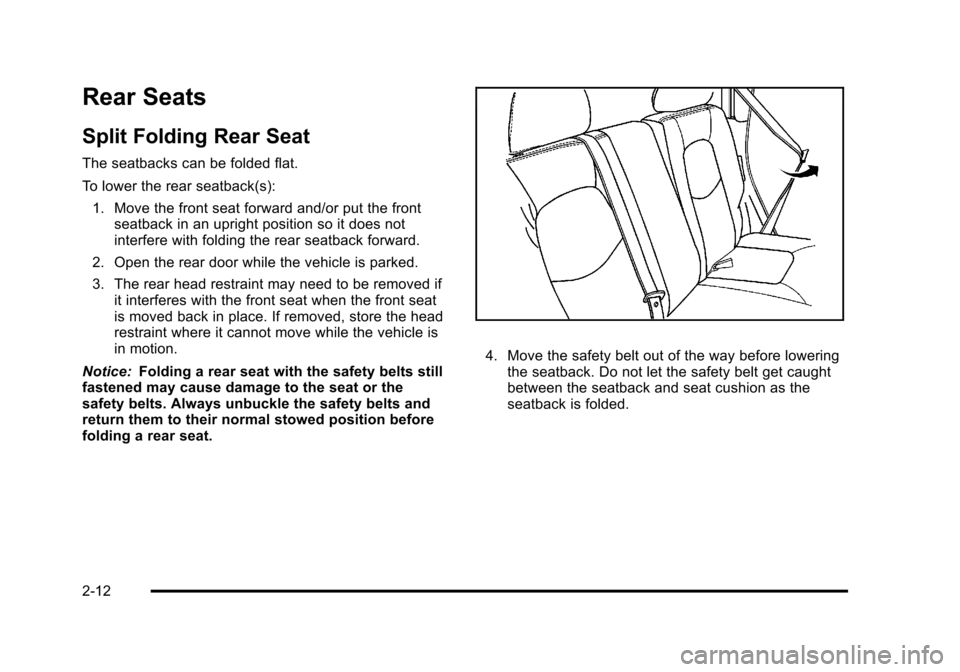
Black plate (12,1)Chevrolet HHR Owner Manual - 2011
Rear Seats
Split Folding Rear Seat
The seatbacks can be folded flat.
To lower the rear seatback(s):1. Move the front seat forward and/or put the front seatback in an upright position so it does not
interfere with folding the rear seatback forward.
2. Open the rear door while the vehicle is parked.
3. The rear head restraint may need to be removed if it interferes with the front seat when the front seat
is moved back in place. If removed, store the head
restraint where it cannot move while the vehicle is
in motion.
Notice: Folding a rear seat with the safety belts still
fastened may cause damage to the seat or the
safety belts. Always unbuckle the safety belts and
return them to their normal stowed position before
folding a rear seat.
4. Move the safety belt out of the way before lowering the seatback. Do not let the safety belt get caught
between the seatback and seat cushion as the
seatback is folded.
2-12
Page 63 of 430
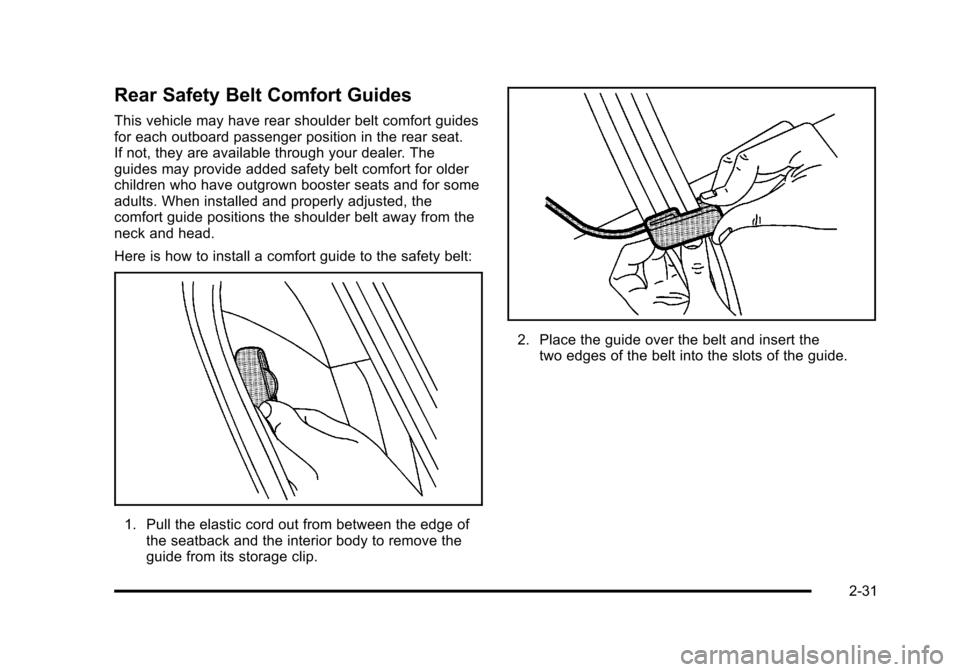
Black plate (31,1)Chevrolet HHR Owner Manual - 2011
Rear Safety Belt Comfort Guides
This vehicle may have rear shoulder belt comfort guides
for each outboard passenger position in the rear seat.
If not, they are available through your dealer. The
guides may provide added safety belt comfort for older
children who have outgrown booster seats and for some
adults. When installed and properly adjusted, the
comfort guide positions the shoulder belt away from the
neck and head.
Here is how to install a comfort guide to the safety belt:
1. Pull the elastic cord out from between the edge ofthe seatback and the interior body to remove the
guide from its storage clip.
2. Place the guide over the belt and insert thetwo edges of the belt into the slots of the guide.
2-31
Page 171 of 430
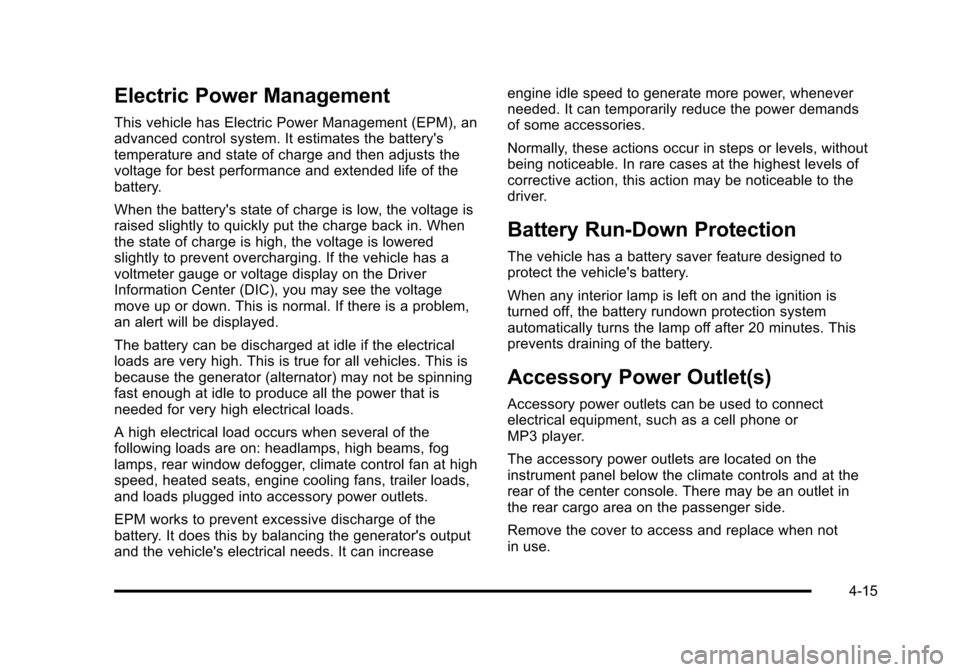
Black plate (15,1)Chevrolet HHR Owner Manual - 2011
Electric Power Management
This vehicle has Electric Power Management (EPM), an
advanced control system. It estimates the battery's
temperature and state of charge and then adjusts the
voltage for best performance and extended life of the
battery.
When the battery's state of charge is low, the voltage is
raised slightly to quickly put the charge back in. When
the state of charge is high, the voltage is lowered
slightly to prevent overcharging. If the vehicle has a
voltmeter gauge or voltage display on the Driver
Information Center (DIC), you may see the voltage
move up or down. This is normal. If there is a problem,
an alert will be displayed.
The battery can be discharged at idle if the electrical
loads are very high. This is true for all vehicles. This is
because the generator (alternator) may not be spinning
fast enough at idle to produce all the power that is
needed for very high electrical loads.
A high electrical load occurs when several of the
following loads are on: headlamps, high beams, fog
lamps, rear window defogger, climate control fan at high
speed, heated seats, engine cooling fans, trailer loads,
and loads plugged into accessory power outlets.
EPM works to prevent excessive discharge of the
battery. It does this by balancing the generator's output
and the vehicle's electrical needs. It can increaseengine idle speed to generate more power, whenever
needed. It can temporarily reduce the power demands
of some accessories.
Normally, these actions occur in steps or levels, without
being noticeable. In rare cases at the highest levels of
corrective action, this action may be noticeable to the
driver.
Battery Run-Down Protection
The vehicle has a battery saver feature designed to
protect the vehicle's battery.
When any interior lamp is left on and the ignition is
turned off, the battery rundown protection system
automatically turns the lamp off after 20 minutes. This
prevents draining of the battery.
Accessory Power Outlet(s)
Accessory power outlets can be used to connect
electrical equipment, such as a cell phone or
MP3 player.
The accessory power outlets are located on the
instrument panel below the climate controls and at the
rear of the center console. There may be an outlet in
the rear cargo area on the passenger side.
Remove the cover to access and replace when not
in use.
4-15
Page 176 of 430
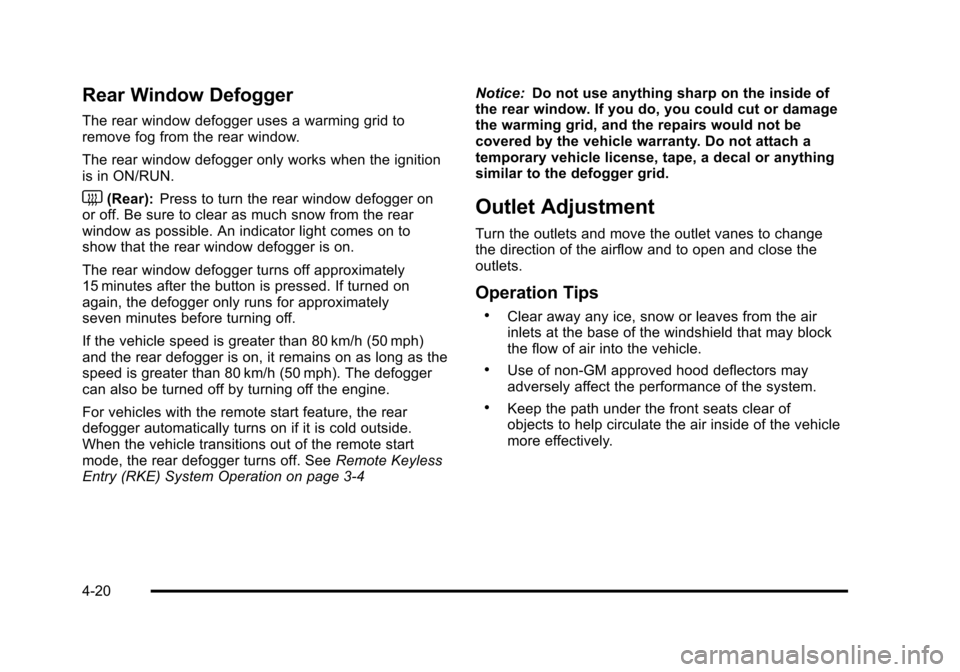
Black plate (20,1)Chevrolet HHR Owner Manual - 2011
Rear Window Defogger
The rear window defogger uses a warming grid to
remove fog from the rear window.
The rear window defogger only works when the ignition
is in ON/RUN.
<(Rear):Press to turn the rear window defogger on
or off. Be sure to clear as much snow from the rear
window as possible. An indicator light comes on to
show that the rear window defogger is on.
The rear window defogger turns off approximately
15 minutes after the button is pressed. If turned on
again, the defogger only runs for approximately
seven minutes before turning off.
If the vehicle speed is greater than 80 km/h (50 mph)
and the rear defogger is on, it remains on as long as the
speed is greater than 80 km/h (50 mph). The defogger
can also be turned off by turning off the engine.
For vehicles with the remote start feature, the rear
defogger automatically turns on if it is cold outside.
When the vehicle transitions out of the remote start
mode, the rear defogger turns off. See Remote Keyless
Entry (RKE) System Operation on page 3‑4 Notice:
Do not use anything sharp on the inside of
the rear window. If you do, you could cut or damage
the warming grid, and the repairs would not be
covered by the vehicle warranty. Do not attach a
temporary vehicle license, tape, a decal or anything
similar to the defogger grid.Outlet Adjustment
Turn the outlets and move the outlet vanes to change
the direction of the airflow and to open and close the
outlets.
Operation Tips
.Clear away any ice, snow or leaves from the air
inlets at the base of the windshield that may block
the flow of air into the vehicle.
.Use of non-GM approved hood deflectors may
adversely affect the performance of the system.
.Keep the path under the front seats clear of
objects to help circulate the air inside of the vehicle
more effectively.
4-20